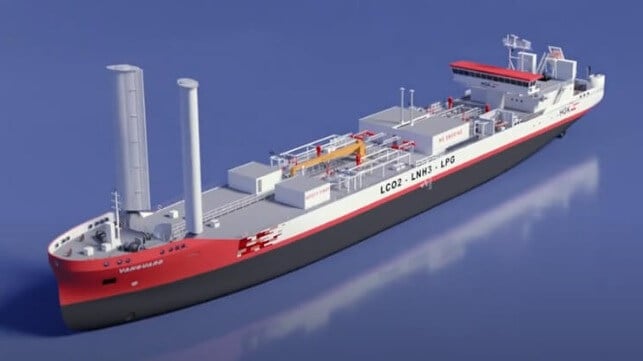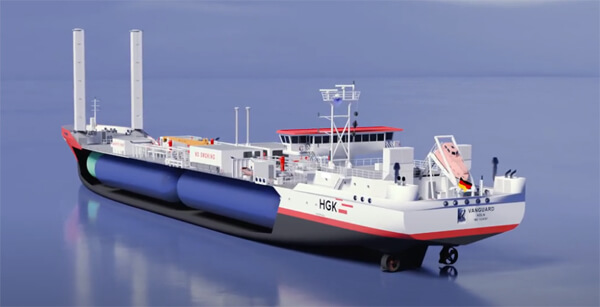Design Concept for Large River-Sea Tanker for LCO2 and Ammonia Transport

German shipping and logistic group HGK (Häfen und Güterverkehr Köln) is presenting a design for a sea-river coaster that they believe can bridge an important gap in the emerging new energy economy. The group’s design builds on the earlier concept for an inland barge to carry liquified CO2 and ammonia adding the capabilities to transition from river to coastal and ocean-going operations.
“The increasing process of decarbonization of the production process is changing the flow of goods,” highlights Steffen Bauer, the CEO of HGK Shipping. The ‘Vanguard’ offers industry additional capacity to safely and sustainably transport liquefied ammonia and carbon dioxide from Scandinavia as far as the Iberian Peninsula and use the seaports as gateways to the network of European inland waterways.”
The design for Vanguard is a 410-foot (125-meter) long and 57-foot (17.5-meter) wide vessel that is capable of sailing on inland waters and beyond. The vessel will have takes to both transport liquified CO2 under pressure and cold liquified ammonia. It would be the first vessel of its kind at this size.
The advantage of the design HGK says is that it can meet the emerging need to transport these two gasses without the need to transship the cargo between different modes of transportation. Vanguard would transport LCO2 from emitters directly to the offshore undersea storage sites. It would also collect ammonia from production sites such as on the Iberian Peninsula and transport it to users in Northern Europe, Germany, and Scandinavia.

Vanguard would have multiple tanks to transport both LCO2 and ammonia (HGK)
The dimensions are suited for sailing on key waterways such as the Rhine and in particular the upper regions where the majority of heavy industries are located. By being able to reach the industrial sites, it eliminated the need for pipeline structures.
The vessel will be powered by a diesel-electric motor. It will also be ready to be ammonia-fueled. While operating inland it would fold down two wind sails and deploy them during coastal or deep-sea operations to improve operating efficiency. The bridge structure would also be lowered to clearance on inland waterways.
Earlier this year, HGK also presented a design concept for its inland barge designed to transport both LCO2 and ammonia. Known as Pioneer, the inland vessel has similar dimensions of 443 feet (135 meters) long and 57 feet (17.5 meters) wide and would have a significant capacity with six tanks that could load ammonia in a cold liquified state or transport captured CO2 in a liquified state. The inland vessel was designed to reach key industries and provide transfer capabilities from coastal seaports.
The vessels would be competitors in the anticipated emerging markets to move large quantities of the two gasses. Ammonia is seen as an alternative fuel as well as a carrier for hydrogen. Hard to decarbonize industries such as those along the Rhine will be required to capture and store CO2 creating the need for vessels to move the captured material to long-term storage sites.
